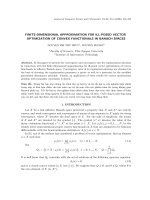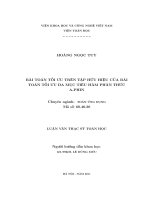Xấp xỉ hữu hạn chiều cho bài toán cực trị đa mục tiêu không chỉnh các phiếm hàm lồi trong không gian Banach. docx
Bạn đang xem bản rút gọn của tài liệu. Xem và tải ngay bản đầy đủ của tài liệu tại đây (162.57 KB, 9 trang )
Journal of Computer Science and Cybernetics, Vol.22, No.3 (2006), 235—243
FINITE-DIMENSIONAL APPROXIMATION FOR ILL-POSED VECTOR
OPTIMIZATION OF CONVEX FUNCTIONALS IN BANACH SPACES
NGUYEN THI THU THUY
1
, NGUYEN BUONG
2
1
Faculty of Sciences, Thai Nguyen University
2
Institute of Information Technology
Abstract. In this paper we present the convergence and convergence rate for regularization solutions
in connection with the finite-dimensional approximation for ill-posed vector optimization of convex
functionals in reflexive Banach space. Convergence rates of its regularized solutions are obtained on
the base of choosing the regularization parameter a priory as well as a posteriori by the modified
generalized discrepancy principle. Finally, an application of these results for convex optimization
problem with inequality constraints is shown.
T´om t˘a
´
t. Trong b`ai b´ao n`ay ch´ung tˆoi tr`ınh b`ay su
.
.
hˆo
.
i tu
.
v`a tˆo
´
c
dˆo
.
hˆo
.
i tu
.
cu
’
a nghiˆe
.
m hiˆe
.
u chı
’
nh
trong xˆa
´
p xı
’
h˜u
.
u ha
.
n chiˆe
`
u cho b`ai to´an cu
.
.
c tri
.
da mu
.
c tiˆeu c´ac phiˆe
´
m h`am lˆo
`
i trong khˆong gian
Banach pha
’
n xa
.
. Tˆo
´
c
dˆo
.
hˆo
.
i tu
.
cu
’
a nghiˆe
.
m hiˆe
.
u chı
’
nh nhˆa
.
n du
.
o
.
.
c du
.
.
a trˆen viˆe
.
c cho
.
n tham sˆo
´
hiˆe
.
u
chı
’
nh tru
.
´o
.
c ho˘a
.
c sau b˘a
`
ng nguyˆen l´y
dˆo
.
lˆe
.
ch suy rˆo
.
ng o
.
’
da
.
ng ca
’
i biˆen. Cuˆo
´
i c`ung l`a mˆo
.
t ´u
.
ng du
.
ng
cu
’
a c´ac kˆe
´
t qua
’
da
.
t du
.
o
.
.
c cho b`ai to´an cu
.
.
c tri
.
lˆo
`
i v´o
.
i r`ang buˆo
.
c bˆa
´
t
d˘a
’
ng th´u
.
c.
1. INTRODUCTION
Let
X
be a real reflexive Banach space preserved a property that
X
and
X
∗
are strictly
convex, and weak convergence and convergence of norms of any sequence in
X
imply its strong
convergence, where
X
∗
denotes the dual space of
X
. For the sake of simplicity, the norms
of
X
and
X
∗
are denoted by the symbol
.
. The symbol
x
∗
, x
denotes the value of the
linear continuous functional
x
∗
∈ X
∗
at the point
x ∈ X
. Let
ϕ
j
(x)
,
j = 0, 1, , N
, be the
weakly lower semicontinuous proper convex functionals on
X
that are assumed to be Gˆateaux
differentiable with the hemicontinuous derivatives
A
j
(x)
at
x ∈ X
.
In [6], one of the authors has considered a problem of vector optimization: find an element
u ∈ X
such that
ϕ
j
(u) = inf
x∈X
ϕ
j
(x), ∀j = 0, 1, , N. (1.1)
Set
Q
j
=
ˆx ∈ X : ϕ
j
(ˆx) = inf
x∈X
ϕ
j
(x)
, j = 0, 1, , N, Q =
N
j=0
Q
j
.
It is well know that
Q
j
coincides with the set of solutions of the following operator equation
A
j
(x) = θ, (1.2)
and is a closed convex subset in
X
(see [11]). We suppose that
Q = ∅
, and
θ /∈ Q
, where
θ
is
the zero element of
X
(or
X
∗
).
236
NGUYEN THI THU THUY, NGUYEN BUONG
In [6] it is showed the existence and uniqueness of the solution
x
h
α
of the operator equation
N
j=0
α
λ
j
A
h
j
(x) + αU(x) = θ, (1.3)
λ
0
= 0 < λ
j
< λ
j+1
< 1, j = 1, 2, , N − 1,
where
α > 0
is the small parameter of regularization,
U
is the normalized duality mapping of
X
, i.e.,
U : X → X
∗
satisfies the condition
U(x), x = x
2
, U(x) = x,
A
h
j
are the hemicontinuous monotone approximations for
A
j
in the forms
A
j
(x) − A
h
j
(x) hg(x), ∀x ∈ X, (1.4)
with level
h → 0
, and
g(t)
is a bounded (the image of the bounded set is bounded) nonnegative
function,
t 0
.
Clairly, the convergence and convergence rates of the sequence
x
h
α
to
u
depend on the
choice of
α = α(h)
. In [6], one has showed that the parameter
α
can be chosen by the
modified generalized discrepancy principle, i.e.,
α = α(h)
is constructed on the basis of the
following equation
ρ(α) = h
p
α
−q
, p, q > 0, (1.5)
where
ρ(α) = α(a
0
+ t(α))
, the function
t(α) = x
h
α
depends continuously on
α α
0
> 0
,
a
0
is some positive constant.
In computation the finite-demensional approximation for (1.3) is the important problem.
As usualy, it can be aproximated by the following equation
N
j=0
α
λ
j
A
hn
j
(x) + αU
n
(x) = θ, x ∈ X
n
, (1.6)
where
A
hn
j
= P
∗
n
A
h
j
P
n
, U
n
= P
∗
n
UP
n
and
P
n
: X −→ X
n
the linear projection from
X
onto
X
n
,
X
n
is the finite-dimensional subspace of
X
,
P
∗
n
is the conjugate of
P
n
,
X
n
⊂ X
n+1
, ∀n, P
n
x −→ x, ∀x ∈ X.
Without loss of generality, suppose that
P
n
= 1
(see [11]).
As for (1.3), equation (1.6) has also an unique solution
x
h
α,n
, and for every fixed
α > 0
the
sequence
{x
h
α,n
}
converges to
x
h
α
, the solution of (1.3), as
n → ∞
(see [11]).
The natural problem is to ask whether the sequence
{x
h
α,n
}
converges to
u
as
α, h → 0
and
n → ∞
, and how fast it converges, where
u
is an element in
Q
. The purpose of this paper is
to answer these questions.
We assume, in addition, that
U
satisfies the condition
U(x) − U(y), x − y m
U
x − y
s
, m
U
> 0, s 2, ∀x, y ∈ X. (1.7)
Set
γ
n
(x) = (I − P
n
)x, x ∈ Q,
where
I
denotes the identity operator in
X
.
FINITE-DIMENSIONAL APPROXIMATION FOR ILL-POSED VECTOR OPTIMIZATION
237
Hereafter the symbols
and
→
indicate weak convergence and convergence in norm,
respectively, while the notation
a ∼ b
is meant
a = O(b)
and
b = O(a).
2. MAIN RESULT
The convergence of
{x
h
α,n
}
to
u
is determined by the following theorem.
Theorem 1. If
h/α
and
γ
n
(x)/α → 0
, as
α → 0
and
n → ∞
, then the sequence
x
h
α,n
converges to
u
.
Proof. For
x ∈ Q, x
n
= P
n
x
, it follows from (1.6) that
N
j=0
α
λ
j
A
hn
j
(x
h
α,n
), x
h
α,n
− x
n
+ αU
n
(x
h
α,n
) − U
n
(x
n
), x
h
α,n
− x
n
= αU
n
(x
n
), x
n
− x
h
α,n
.
Therefore, on the basis of (1.2), (1.7) and the monotonicity of
A
hn
j
= P
∗
n
A
h
j
P
n
, and
P
n
P
n
= P
n
we have
αm
U
x
h
α,n
− x
n
s
αU (x
h
α,n
) − U(x
n
), x
h
α,n
− x
n
= αU
n
(x
h
α,n
) − U
n
(x
n
), x
h
α,n
− x
n
=
N
j=0
α
λ
j
A
hn
j
(x
h
α,n
), x
n
− x
h
α,n
+ αU
n
(x
n
), x
n
− x
h
α,n
N
j=0
α
λ
j
A
hn
j
(x
n
), x
n
− x
h
α,n
+ αU
n
(x
n
), x
n
− x
h
α,n
=
N
j=0
α
λ
j
A
h
j
(x
n
) − A
j
(x
n
) + A
j
(x
n
) − A
j
(x), x
n
− x
h
α,n
+ αU(x
n
), x
n
− x
h
α,n
. (2.1)
On the other hand, by using (1.4) and
A
j
(x
n
) − A
j
(x) Kγ
n
(x),
where
K
is some positive constant depending only on
x
, it follows from (2.1) that
m
U
x
h
α,n
− x
n
s
1
α
(N + 1)
hg(x
n
) + Kγ
n
(x)
x
n
− x
h
α,n
+ U(x
n
), x
n
− x
h
α,n
. (2.2)
Because of
h/α
,
γ
n
(x)/α → 0
as
α → 0
,
n → ∞
and
s 2
, this inequality gives us the
boundedness of the sequence
{x
h
α,n
}
. Then, there exists a subsequence of the sequence
{x
h
α,n
}
converging weakly to
ˆx
in
X
. Without loss of generality, we assume that
x
h
α,n
ˆx
as
h, h/α → 0
and
n → ∞
. First, we prove that
ˆx ∈ Q
0
. Indeed, by virtue of the monotonicity
of
A
hn
j
= P
∗
n
A
h
j
P
n
,
U
n
= P
∗
n
UP
n
and (1.6) we have
A
hn
0
(P
n
x), P
n
x − x
h
α,n
A
hn
0
(x
h
α,n
), P
n
x − x
h
α,n
=
N
j=1
α
λ
j
A
hn
j
(x
h
α,n
), x
h
α,n
− P
n
x + αU
n
(x
h
α,n
), x
h
α,n
− P
n
x
N
j=1
α
λ
j
A
hn
j
(P
n
x), x
h
α,n
− P
n
x + αU
n
(P
n
x), x
h
α,n
− P
n
x, ∀x ∈ X.
238
NGUYEN THI THU THUY, NGUYEN BUONG
Because of
P
n
P
n
= P
n
, so the last inequality has form
A
h
0
(P
n
x), P
n
x − x
h
α,n
N
j=1
α
λ
j
A
h
j
(P
n
x), x
h
α,n
− P
n
x + αU (P
n
x), x
h
α,n
− P
n
x, ∀x ∈ X.
By letting
h, α → 0
and
n → ∞
in this inequality we obtain
A
0
(x), x − ˆx 0, ∀x ∈ X.
Consequently,
ˆx ∈ Q
0
(see [11]). Now, we shall prove that
ˆx ∈ Q
j
,
j = 1, 2, , N
. Indeed, by
(1.6) and making use of the monotonicity of
A
hn
j
and
U
n
, it follows that
α
λ
1
A
hn
1
(x
h
α,n
),x
h
α,n
− P
n
x +
N
j=2
α
λ
j
A
hn
j
(x
h
α,n
), x
h
α,n
− P
n
x + αU
n
(x
h
α,n
), x
h
α,n
− P
n
x
= α
λ
0
A
hn
0
(x
h
α,n
), P
n
x − x
h
α,n
A
hn
0
(P
n
x), P
n
x − x
h
α,n
= A
h
0
(P
n
x) − A
0
(P
n
x) + A
0
(P
n
x) − A
0
(x), P
n
x − x
h
α,n
, ∀x ∈ Q
0
.
Therefore,
A
h
1
(P
n
x), x
h
α,n
− P
n
x +
N
j=2
α
λ
j
−λ
1
A
h
j
(P
n
x), x
h
α,n
− P
n
x + α
1−λ
1
U(P
n
x), x
h
α,n
− P
n
x
1
α
hα
1−λ
1
g(P
n
x) + Kγ
n
(x)
P
n
x − x
h
α,n
, ∀x ∈ Q
0
.
After passing
h, α → 0
and
n → ∞
, we obtain
A
1
(x), ˆx − x 0, ∀x ∈ Q
0
.
Thus,
ˆx
is a local minimizer for
ϕ
1
on
S
0
(see [9]). Since
S
0
∩ S
1
= ∅
, then
ˆx
is also a global
minimizer for
ϕ
1
, i.e.,
ˆx ∈ S
1
.
Set
˜
Q
i
= ∩
i
k=0
Q
k
. Then,
˜
Q
i
is also closed convex, and
˜
Q
i
= ∅
.
Now, suppose that we have proved
ˆx ∈
˜
Q
i
and we need to show that
ˆx
belongs to
Q
i+1
.
Again, by virtue of (1.6) for
x ∈
˜
Q
i
, we can write
A
hn
i+1
(x
h
α,n
), x
h
α,n
− P
n
x +
N
j=i+2
α
λ
j
−λ
i+1
A
hn
j
(x
h
α,n
), x
h
α,n
− P
n
x
+ α
1−λ
i+1
U
n
(x
h
α,n
), x
h
α,n
− P
n
x =
i
k=0
α
λ
k
−λ
i+1
A
hn
k
(x
h
α,n
), P
n
x − x
h
α,n
1
α
i
k=0
α
λ
k
+1−λ
i+1
A
h
k
(P
n
x) − A
k
(P
n
x) + A
k
(P
n
x) − A
k
(x), P
n
x − x
h
α,n
1
α
(i + 1)
hg(P
n
x) + Kγ
n
(x)
P
n
(x) − x
h
α,n
.
Therefore,
FINITE-DIMENSIONAL APPROXIMATION FOR ILL-POSED VECTOR OPTIMIZATION
239
A
h
i+1
(P
n
x), x
h
α,n
− P
n
x +
N
j=i+2
α
λ
j
−λ
i+1
A
h
j
(P
n
x), x
h
α,n
− P
n
x
+α
1−λ
i+1
U(P
n
x), x
h
α,n
− P
n
x
hg(P
n
x) + Kγ
n
(x)
α
(N + 1)P
n
x − x
h
α,n
.
By letting
h, α → 0
and
n → ∞
, we have
A
i+1
(x), ˆx − x 0, ∀x ∈
˜
Q
i
.
As a result,
ˆx ∈ Q
i+1
.
On the other hand, it follows from (2.2) that
U(x), x − ˆx 0, ∀x ∈ Q.
Since
Q
j
is closed convex,
Q
is also closed convex. Replacing
x
by
tˆx + (1 − t)x
,
t ∈ (0, 1)
in
the last inequality, and dividing by
(1 − t)
and letting
t
to
1
, we obtain
U(ˆx), x − ˆx 0, ∀x ∈ Q.
Hence
ˆx x
,
∀x ∈ Q
. Because of the convexity and the closedness of
Q
, and the strictly
convexity of
X
we deduce that
ˆx = u
. So, all sequence
{x
h
α,n
}
converges weakly to
u
. Set
x
n
= u
n
= P
n
u
in (2.2) we deduce that the sequence
{x
h
α,n
}
converges strongly to
u
as
h → 0
and
n → ∞
. The proof is complete.
In the following, we consider the finite-dimensional variant of the generalized discrepancy
principle for the choice
˜α = α(h, n)
so that
x
h
˜α,n
converges to
u
, as
h, α → 0
and
n → ∞
.
Note that, the generalized discrepancy principle for parameter choice is presented first in
[8] for the linear ill-posed problems. For the nonlinear ill-posed equation involving a monotone
operator in Banach space the use of a discrepancy principle to estimate the rate of convergence
of the regularized solutions was considered in [5]. In [4] the convergence rates of regularized
solutions of ill-posed variational inequalities under arbitrary perturbative operators were in-
vestigated when the regularization parameter was chosen arbitrarily such that
α ∼ (δ + ε)
p
,
0 < p < 1
. In this paper, we consider the modified generalized discrepancy principle for
selecting
˜α
in connection with the finite-dimensional and obtain the rates of convergence for
the regularized solutions in this case.
The parameter
α(h, n)
can be chosen by
α(a
0
+ x
h
α,n
) = h
p
α
−q
, p, q > 0 (2.3)
for each
h > 0
and
n
. It is not difficult to verify that
ρ
n
(α) = α(a
0
+ x
h
α,n
)
possesses all
properties as well as
ρ(α)
does, and
lim
α→+∞
α
q
ρ
n
(α) = +∞, lim
α→+0
α
q
ρ
n
(α) = 0.
To find
α
by (2.3) is very complex. So, we consider the following rule.
The rule. Choose
˜α = α(h, n) α
0
:= (c
1
h + c
2
γ
n
)
p
,
c
i
> 1, i = 1, 2
,
0 < p < 1
such that
the following inequalities
˜α
1+q
(a
0
+ x
h
˜α,n
) d
1
h
p
,
˜α
1+q
(a
0
+ x
h
˜α,n
) d
2
h
p
, d
2
d
1
> 1,
240
NGUYEN THI THU THUY, NGUYEN BUONG
hold.
In addition, assume that
U
satisfies the following condition
U(x) − U(y) C(R)x − y
ν
, 0 < ν 1, (2.4)
where
C(R), R > 0
, is a positive increasing function on
R = max{x, y}
(see [10]).
Set
γ
n
= max
x∈Q
{γ
n
(x)}.
Lemma 1.
lim
h→0
n→∞
α(h, n) = 0.
Proof. Obviously, it follows from the rule that
α(h, n) d
1/(1+q)
2
a
0
+ x
h
α(h,n),n
−1/(1+q)
h
p/(1+q)
d
1/(q+1)
2
a
−1/(1+q)
0
h
p/(1+q)
.
Lemma 2. If
0 < p < 1
then
lim
h→0
n→∞
h + γ
n
α(h, n)
= 0.
Proof. Obviously using the rule we get
h + γ
n
α(h, n)
c
1
h + c
2
γ
n
(c
1
h + c
2
γ
n
)
p
= (c
1
h + c
2
γ
n
)
1−p
→ 0
as
h → 0
and
n → ∞
.
Now, let
x
h
˜α,n
be the solution of (1.6) with
α = ˜α
. By the argument in the proof of
Theorem 1, we obtain the following result.
Theorem 2. The sequence
x
h
˜α,n
converges to
u
as
h → 0
and
n → ∞
.
The next theorem shows the convergence rates of
{x
h
˜α,n
}
to
u
as
h → 0
and
n → ∞
.
Theorem 3. Assume that the following conditions hold:
(i)
A
0
is continuously Frchet differentiable, and satifies the condition
A
0
(x) − A
0
(u)(x − u) τA
0
(x), ∀u ∈ Q,
where
τ
is a positive constant, and
x
belongs to some neighbourhood of
Q
;
(ii)
A
h
(X
n
)
are contained in
X
∗
n
for sufficiently large
n
and small
h
;
(iii)
there exists an element
z ∈ X
such that
A
0
(u)
∗
z = U(u)
;
(vi)
the parameter
˜α = α(h, n)
is chosen by the rule.
Then, we have
x
h
˜α,n
− u = O
(h + γ
n
)
η
1
+ γ
η
2
n
,
η
1
= min
1 − p
s − 1
,
µ
1
p
s(1 + q)
, η
2
= min
1
s
,
ν
s − 1
.
FINITE-DIMENSIONAL APPROXIMATION FOR ILL-POSED VECTOR OPTIMIZATION
241
Proof. Replacing
x
n
by
u
n
= P
n
u
in
(2.2)
we obtain
m
U
x
h
˜α,n
− u
n
s
1
˜α
(N + 1)hg(u
n
) + Kγ
n
u
n
− x
h
˜α,n
+U(u
n
) + U(u) − U(u), u
n
− x
h
˜α,n
. (2.5)
By
(2.4)
it follows that
U(u
n
) − U(u), u
n
− x
h
˜α,n
C(
˜
R)u
n
− u
ν
u
n
− x
h
˜α,n
C(
˜
R)γ
ν
n
u
n
− x
h
˜α,n
, (2.6)
where
˜
R > u.
On the other hand, using conditions
(i), (ii), (iii)
of the theorem we can write
U(u), u
n
− x
h
˜α,n
= U(u), u
n
− u + z, A
0
(u)(u − x
h
˜α,n
)
˜
Rγ
n
+ z(τ + 1)A
0
(x
h
˜α,n
)
˜
Rγ
n
+ z(τ + 1)
hg(x
h
˜α,n
) + A
h
0
(x
h
˜α,n
)
˜
Rγ
n
+ z(τ + 1)
N
j=1
˜α
λ
j
A
h
j
(x
h
˜α,n
) + ˜αx
h
˜α,n
+ hg(x
h
˜α,n
)
. (2.7)
Combining (2.6) and (2.7) inequality (2.5) has form
m
U
x
h
˜α,n
− u
n
s
1
˜α
(N + 1)hg(u
n
) + Kγ
n
u
n
− x
h
˜α,n
+ C(
˜
R)γ
ν
n
u
n
− x
h
˜α,n
+
˜
Rγ
n
+ z(τ + 1)
N
j=1
˜α
λ
j
A
h
j
(x
h
˜α,n
) + ˜αx
h
˜α,n
+ hg(x
h
˜α,n
)
. (2.8)
On the other hand, making use of the rule and the boundedness of
{x
h
˜α,n
}
it implies that
˜α = α(h, n) (c
1
h + c
2
γ
n
)
p
,
˜α = α(h, n) C
1
h
p/(1+q)
, C
1
> 0,
˜α = α(h, n) 1,
for sufficiently small
h
and large
n
.
Consequently, in view of (2.8) it follows that
m
U
x
h
˜α,n
− u
n
(N + 1)hg(u
n
) + Kγ
n
(c
1
h + c
2
γ
n
)
p
+ C(
˜
R)γ
ν
n
u
n
− x
h
˜α,n
+
˜
Rγ
n
+ C
2
(h + γ
n
)
λ
1
p/(1+q)
˜
C
1
(h + γ
n
)
1−p
+ γ
ν
n
u
n
− x
h
˜α,n
+
˜
C
2
γ
n
+
˜
C
3
(h + γ
n
)
λ
1
p/(1+q)
,
C
2
and
˜
C
i
,
i = 1, 2, 3
are the positive constants.
242
NGUYEN THI THU THUY, NGUYEN BUONG
Using the implication
a, b, c 0, p
1
> q
1
, a
p
1
ba
q
1
+ c ⇒ a
p
1
= O
b
p
1
/(p
1
−q
1
)
+ c
we obtain
x
h
˜α,n
− u
n
= O
(h + γ
n
)
η
1
+ γ
η
2
n
.
Thus,
x
h
˜α,n
− u = O
(h + γ
n
)
η
1
+ γ
η
2
n
,
which completes the proof.
Remarks. If
˜α = α(h, n)
is chosen a priori such that
˜α ∼ (h + γ
n
)
η
,
0 < η < 1
, then
inequality (2.8) has the form
m
U
x
h
˜α,n
− u
n
C
1
(h + γ
n
)
1−η
+ γ
ν
n
u
n
− x
h
˜α,n
+ C
2
γ
n
+ C
3
(h + γ
n
)
λ
1
η
,
where
C
i
, i = 1, 2, 3
are the positive constants.
Therefore,
x
h
˜α,n
− u
n
= O
(h + γ
n
)
θ
1
+ γ
θ
2
n
,
whence,
x
h
˜α,n
− u = O
(h + γ
n
)
θ
1
+ γ
θ
2
n
,
θ
1
= min
1 − η
s − 1
,
λ
1
η
s
, θ
2
= min
1
s
,
ν
s − 1
.
3. AN APPLICATION
In this section we consider a constrained optimization problem:
inf
x∈X
f
N
(x) (3.1)
subject to
f
j
(x) 0, j = 0, , N − 1, (3.2)
where
f
0
, f
1
, , f
N
are weakly lower semicontinuous and properly convex functionals on
X
that are assumed to be Gteaux differentiable at
x ∈ X
.
Set
Q
j
= {x ∈ X : f
j
(x) 0}, j = 0, , N − 1. (3.3)
Obviously,
Q
j
is the closed convex subset of
X
,
j = 0, , N − 1
.
Define
ϕ
N
(x) = f
N
(x), ϕ
j
(x) = max{0, f
j
(x)}, j = 0, , N − 1. (3.4)
Evidently,
ϕ
j
are also convex functionals on
X
and
Q
j
= {¯x ∈ X : ϕ
j
(¯x) = inf
x∈X
ϕ
j
(x)}, 0, 1, , N.
So,
¯x
is a solution of the problem:
ϕ
j
(¯x) = inf
x∈X
ϕ
j
(x), ∀j = 0, 1, , N.
FINITE-DIMENSIONAL APPROXIMATION FOR ILL-POSED VECTOR OPTIMIZATION
243
REFERENCES
[1] Ya. I. Alber, On solving nonlinear equations involving monotone operators in banach
spaces, Sib. Mat. Zh. 26 (1975) 3—11.
[2] Ya.I. Alber and I. P. Ryazantseva, On solutions of nonlinear problems involving monotone
discontinuous operators, Differ. Uravn. 25 (1979) 331—342.
[3] V. Barbu, Nonlinear Semigroups and Differential Equations in Banach Spaces, Noordhoff
Int. Publ. Leyden (Ed. Acad. Bucuresti, Romania, Netherlands) 1976.
[4] Ng. Buong, Convergence rates and finite-dimensional approximation for a class of ill-posed
variational inequalities, Ukrainian Math. J. 49 (1997) 629—637.
[5] Ng. Buong, On a monotone ill-posed problem, Acta Mathematica Sinica, English Series
21 (2005) 1001—1004.
[6] Ng. Buong, Regularization for unconstrained vector optimization of convex functionals
in Banach spaces, Comp. Mat. and Mat. Phy. 46 (2006) 354—360.
[7] I. Ekeland and R. Temam, Convex analysis and variational problems, North-Holland Publ.
Company, Amsterdam, Holland, 1970.
[8] H. W. Engl, Discrepancy principle for tikhonov regularization of ill-posed problems lead-
ing to optimal convergence rates, J. of Optimization Theory and Appl. 52 (1987) 209—215.
[9] I. P. Ryazantseva, Operator method of ragularization for problems of optimal program-
ming with monotone maps, Sib. Mat. Zh. 24 (1983) 214.
[10] I. P. Ryazantseva, An algorithm for solving nonlinear monotone equations with unknown
input data error bound, USSR Comput. Mat. and Mat. Phys. 29 (1989) 225—229.
[11] M. M. Vainberg, Variational Method and Method of Monotone Operators in the Theory
of Nonlinear Equations, New York, John Wiley, 1973.
Received on May 29, 2006
Revised on August 2, 2006









